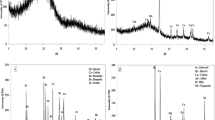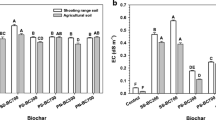Abstract
High concentration of toxic metals in military shooting range soils poses a significant environmental concern due to the potential release of metals, such as Pb, Cu, and Sb, and hence requires remediation. The current study examined the effectiveness of buffalo weed (Ambrosia trifida L.) biomass and its derived biochars at pyrolytic temperatures of 300 and 700 °C, natural iron oxides (NRE), gibbsite, and silver nanoparticles on metal immobilization together with soil quality after 1-year soil incubation. Destructive (e.g., chemical extractions) and non-destructive (e.g., molecular spectroscopy) methods were used to investigate the immobilization efficacy of each amendment on Pb, Cu, and Sb, and to explore the possible immobilization mechanisms. The highest immobilization efficacy was observed with biochar produced at 300 °C, showing the maximum decreases of bioavailability by 94 and 70 % for Pb and Cu, respectively, which were attributed to the abundance of functional groups in the biochar. Biochar significantly increased the soil pH, cation exchange capacity, and P contents. Indeed, the scanning electron microscopic elemental dot mapping and X-ray absorption fine structure spectroscopic (EXAFS) studies revealed associations of Pb with P (i.e., the formation of stable chloropyromorphite [Pb5(PO4)3Cl]) in the biomass- or biochar-amended soils. However, no amendment was effective on Sb immobilization.




Similar content being viewed by others
References
Adriano, D. C., Wenzel, W. W., Vangronsveld, J., & Bolan, N. S. (2004). Role of assisted natural remediation in environmental cleanup. Geoderma, 122, 121–142.
Ahmad, M., Hashimoto, Y., Moon, D. H., Lee, S. S., & Ok, Y. S. (2012a). Immobilization of lead in a Korean military shooting range soil using eggshell waste: An integrated mechanistic approach. Journal of Hazardous Materials, 209–210, 392–401.
Ahmad, M., Lee, S. S., Yang, J. E., Ro, H. M., Han Lee, Y., & Ok, Y. S. (2012b). Effects of soil dilution and amendments (mussel shell, cow bone, and biochar) on Pb availability and phytotoxicity in military shooting range soil. Ecotoxicology and Environmental Safety, 79, 225–231.
Ahmad, M., Moon, D. H., Lim, K. J., Shope, C. L., Lee, S. S., Usman, A. R. A., et al. (2012c). An assessment of the utilization of waste resources for the immobilization of Pb and Cu in the soil from a Korean military shooting range. Environmental Earth Sciences, 67, 1023–1031.
Ahmad, M., Lee, S. S., Lim, J. E., Lee, S. E., Cho, J. S., Moon, D. H., et al. (2014a). Speciation and phytoavailability of lead and antimony in a small arms range soil amended with mussel shell, cow bone and biochar: EXAFS spectroscopy and chemical extractions. Chemosphere, 95, 433–441.
Ahmad, M., Moon, D. H., Vithanage, M., Koutsospyros, A., Lee, S. S., Yang, J. E., et al. (2014b). Production and use of biochar from buffalo-weed (Ambrosia trifida L.) for trichloroethylene removal from water. Journal of Chemical Technology and Biotechnology, 89, 150–157.
Ahmad, M., Rajapaksha, A. U., Lim, J. E., Zhang, M., Bolan, N., Mohan, D., et al. (2014c). Biochar as a sorbent for contaminant management in soil and water: A review. Chemosphere, 99, 19–33.
Almaroai, Y. A., Vithanage, M., Rajapaksha, A. U., Lee, S. S., Dou, X., Lee, Y. H., et al. (2014). Natural and synthesised iron-rich amendments for As and Pb immobilisation in agricultural soil. Chemistry and Ecology, 30, 267–279.
Alqudami, A., Alhemiery, N. A., & Munassar, S. (2012). Removal of Pb(II) and Cd(II) ions from water by Fe and Ag nanoparticles prepared using electro-exploding wire technique. Environmental Science and Pollution Research, 19, 2832–2841.
Bolan, N., Adriano, D., & Naidu, R. (2003). Role of phosphorus in (Im)mobilization and bioavailability of heavy metals in the soil-plant system. In G. Ware (Ed.), Reviews of environmental contamination and toxicology (Vol. 177, pp. 1–44). New York: Springer.
Bolan, N., Kunhikrishnan, A., Thangarajan, R., Kumpiene, J., Park, J., Makino, T., et al. (2014). Remediation of heavy metal(loid)s contaminated soils—To mobilize or to immobilize? Journal of Hazardous Materials, 266, 141–166.
Brown, S., Chaney, R. L., Hallfrisch, J. G., & Xue, Q. (2003). Effect of biosolids processing on lead bioavailability in an urban soil. Journal of Environmental Quality, 32, 100–108.
Cao, X., & Dermatas, D. (2008). Evaluating the applicability of regulatory leaching tests for assessing lead leachability in contaminated shooting range soils. Environmental Monitoring and Assessment, 139, 1–13.
Cao, X., Dermatas, D., Xu, X., & Shen, G. (2008). Immobilization of lead in shooting range soils by means of cement, quicklime, and phosphate amendments. Environmental Science and Pollution Research, 15, 120–127.
Cao, X., Ma, L. Q., Chen, M., Hardison, D. W., & Harris, W. G. (2003). Lead transformation and distribution in the soils of shooting ranges in Florida, USA. Science of the Total Environment, 307, 179–189.
Cao, X., Ma, L., Liang, Y., Gao, B., & Harris, W. (2011). Simultaneous immobilization of lead and atrazine in contaminated soils using dairy-manure biochar. Environmental Science and Technology, 45, 4884–4889.
Chan, K. Y., Van Zwieten, L., Meszaros, I., Downie, A., & Joseph, S. (2007). Agronomic values of greenwaste biochar as a soil amendment. Soil Research, 45, 629–634.
Dermatas, D., Shen, G., Chrysochoou, M., Grubb, D. G., Menounou, N., & Dutko, P. (2006). Pb speciation versus TCLP release in army firing range soils. Journal of Hazardous Materials, 136, 34–46.
EPA. (1991). Test methods for evaluating solid wastes. Physical/chemical methods, Method 1311; EPA/530/SW-846; U.S. Environmental Protection Agency.
Filella, M., Williams, P. A., & Belzile, N. (2009). Antimony in the environment: Knowns and unknowns. Environmental Chemistry, 6, 95–105.
Frost, R. L., & Palmer, S. J. (2011). Vibrational spectroscopic study of the mineral tsumebite Pb2Cu(PO4, SO4)(OH). Spectrochimica Acta Part A, 79, 1794–1797.
Gee, G. W., & Or, D. (2002). Particle size analysis. In A. W. Dick (Ed.), Methods of soil analysis, Part 4, physical methods (pp. 278–282). Madison, Wisconsin: Soil Science Society of America Inc.
Hashimoto, Y. (2013). Field and laboratory assessments on dissolution and fractionation of Pb from spent and unspent shots in the rhizosphere soil. Chemosphere, 93, 2894–2900.
Hettiarachchi, G. M., & Pierzynski, G. M. (2004). Soil lead bioavailability and in situ remediation of lead-contaminated soils: A review. Environmental Progress, 23, 78–93.
Jastrow, J., Amonette, J., & Bailey, V. (2007). Mechanisms controlling soil carbon turnover and their potential application for enhancing carbon sequestration. Climatic Change, 80, 5–23.
Jo, I. S., & Koh, M. H. (2004). Chemical changes in agricultural soils of Korea: Data review and suggested countermeasures. Environmental Geochemistry and Health, 26, 105–117.
Karn, B., Kuiken, T., & Otto, M. (2009). Nanotehnology and in situ remediation: A review of the benefits and potential risks. Environmental Helath Perspectives, 117, 1823–1831.
Klitzke, S., & Lang, F. (2009). Mobilization of soluble and dispersible lead, arsenic, and antimony in a polluted, organic-rich soil—Effects of pH increase and counterion valency. Journal of Environmental Quality, 38, 933–939.
Kumara, C. K., Ng, W. J., Bandara, A., & Weerasooriya, R. (2010). Nanogibbsite: Synthesis and characterization. Journal of Colloid and Interface Science, 352, 252–258.
Lim, J. E., Ahmad, M., Lee, S. S., Shope, C. L., Hashimoto, Y., Kim, K. R., et al. (2013). Effects of lime-based waste materials on immobilization and phytoavailability of cadmium and lead in contaminated soil. Clean–Soil, Air, Water, 41, 1235–1241.
Ma, Q. Y., Logan, T. J., & Traina, S. J. (1995). Lead immobilization from aqueous solutions and contaminated soils using phosphate rocks. Environmental Science and Technology, 29, 1118–1126.
MOE. (2010). The Korean standard test (KST) methods for soils. Gwacheon: Korean Ministry of Environment.
Moon, D. H., Park, J. W., Chang, Y. Y., Ok, Y. S., Lee, S. S., Ahmad, M., et al. (2013a). Immobilization of lead in contaminated firing range soil using biochar. Environmental Science and Pollution Research, 20, 8464–8471.
Moon, D. H., Park, J. W., Cheong, K. H., Hyun, S., Koutsospyros, A., Park, J. H., et al. (2013b). Stabilization of lead and copper contaminated firing range soil using calcined oyster shells and fly ash. Environmental Geochemistry and Health, 35, 705–714.
Mulligan, C. N., Yong, R. N., & Gibbs, B. F. (2001). Remediation technologies for metal-contaminated soils and groundwater: An evaluation. Engineering Geology, 60, 193–207.
NIAST. (2000). Method of soil and plant analysis. Suwon: National Institute of Agricultural Science and Technology.
Ok, Y. S., Kim, S. C., Kim, D. K., Skousen, J. G., Lee, J. S., Cheong, Y. W., et al. (2011). Ameliorants to immobilize Cd in rice paddy soils contaminated by abandoned metal mines in Korea. Environmental Geochemistry and Health, 33, 23–30.
Ok, Y. S., Yang, J. E., Zhang, Y. S., Kim, S. J., & Chung, D. Y. (2007). Heavy metal adsorption by a formulated zeolite-Portland cement mixture. Journal of Hazardous Materials, 147, 91–96.
Okkenhaug, G., Amstätter, K., Bue, H. L., Cornelisses, G., Breedveld, G. D., Henriksen, T., & Mulder, J. (2013). Antimony (Sb) contaminated shooting range soil: Sb mobility and immobilization by soil amendments. Environmental Science and Technology, 47, 6431–6439.
Park, J. H., Lamb, D., Paneerselvam, P., Choppala, G., Bolan, N., & Chung, J.-W. (2011). Role of organic amendments on enhanced bioremediation of heavy metal(loid) contaminated soils. Journal of Hazardous Materials, 185, 549–574.
Porter, S. K., Scheckel, K. G., Impellitteri, C. A., & Ryan, J. A. (2004). Toxic metals in the environment: Thermodynamic considerations for possible immobilization strategies for Pb, Cd, As, and Hg. Critical Reviews in Environmental Science and Technology, 34, 495–604.
Rajapaksha, A. U., Vithanage, M., Jayarathna, L., & Kumara, C. K. (2011). Natural red earth as a low cost material for arsenic removal: Kinetics and the effect of competing ions. Applied Geochemistry, 26, 648–654.
Ravel, B., & Newville, M. (2005). Athena, artemis, hephaestus: Data analysis for X-ray absorption spectroscopy using IFEFFIT. Journal of Synchrotron Radiation, 12, 537–541.
Sharma, S. N. A., Prakash, A., Singh, V., Ghosh, A., & Mehta, B. (2010). Synthesis of crystalline Ag nanoparticles (AgNPs) from Microorganisms. Materials Sciences and Applications, 1, 1–7.
Tsang, D. C. W., Yip, A. C. K., Olds, W. E., & Weber, P. A. (2014). Arsenic and copper stabilisation in a contaminated soil by coal fly ash and green waste compost. Environmental Science and Pollution Research, 21, 10194–10204.
Uchimiya, M., Bannon, D. I., & Wartelle, L. H. (2012). Retention of heavy metals by carboxyl functional groups of biochars in small arms range soil. Journal of Agricultural and Food Chemistry, 60, 1798–1809.
Vithanage, M., Rajapaksha, A. U., Dou, X., Bolan, N. S., Yang, J. E., & Ok, Y. S. (2013). Surface complexation modeling and spectroscopic evidence of antimony adsorption on iron-oxide-rich red earth soils. Journal of Colloid and Interface Science, 406, 217–224.
Vithanage, M., Senevirathna, W., Chandrajith, R., & Weerasooriya, R. (2007). Arsenic binding mechanisms on natural red earth: A potential substrate for pollution control. Science of the Total Environment, 379, 244–248.
Walkley, A., & Black, I. A. (1934). An examination of Degtjareff method for determining soil organic matter and a proposed modification of the chromic acid titration method. Soil Science, 37, 29–37.
Weil, R. R., Islam, K. R., Stine, M. A., Gruver, J. B., & Samson-Liebig, S. E. (2003). Estimating active carbon for soil quality assessment: A simplified method for laboratory and field use. American Journal of Alternative Agriculture, 18, 3–17.
Acknowledgments
This research was supported by the Basic Science Research Program, through the National Research Foundation of Korea (NRF), funded by the Ministry of Education, Science and Technology (Project No.: 2012R1A1B3001409) (70 %). This study was also partly supported by the “Research Program for Agricultural Science and Technology Development (Project No. PJ009219042014)”, National Academy of Agricultural Science, RDA, Korea.
Author information
Authors and Affiliations
Corresponding authors
Electronic supplementary material
Below is the link to the electronic supplementary material.
Rights and permissions
About this article
Cite this article
Rajapaksha, A.U., Ahmad, M., Vithanage, M. et al. The role of biochar, natural iron oxides, and nanomaterials as soil amendments for immobilizing metals in shooting range soil. Environ Geochem Health 37, 931–942 (2015). https://doi.org/10.1007/s10653-015-9694-z
Received:
Accepted:
Published:
Issue Date:
DOI: https://doi.org/10.1007/s10653-015-9694-z




